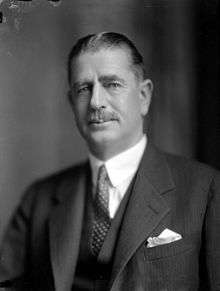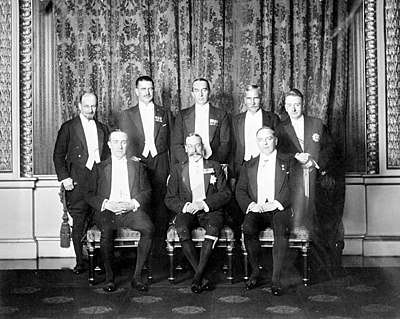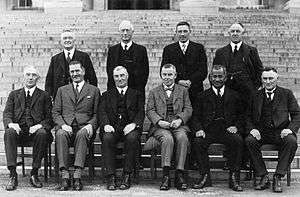Gordon Coates
Joseph Gordon Coates MC* PC (3 February 1878 – 27 May 1943) served as the 21st Prime Minister of New Zealand from 1925 to 1928. He was the third successive Reform prime minister since 1912.
Joseph Gordon Coates MC* | |
|---|---|
 | |
| 21st Prime Minister of New Zealand | |
| In office 30 May 1925 – 10 December 1928 | |
| Monarch | George V |
| Governor-General | Charles Fergusson |
| Preceded by | Francis Bell |
| Succeeded by | Joseph Ward |
| Member of the New Zealand Parliament for Kaipara | |
| In office 1911–1943 | |
| Preceded by | John Stallworthy |
| Succeeded by | Clifton Webb |
| Personal details | |
| Born | 3 February 1878 Hukatere, New Zealand |
| Died | 27 May 1943 (aged 65) Wellington, New Zealand |
| Political party | Reform |
| Spouse(s) | Marjorie Grace Coles ( m. 1914) |
| Children | 5 |
| Awards | MC and bar |
| Signature |  |
| Military service | |
| Allegiance | New Zealand Army |
| Years of service | 1916–18 |
| Rank | |
| Battles/wars | World War I |
Coates was a farmer before becoming a Member of Parliament, and he maintained a focus on farming interests throughout his political career. He was elected to Parliament in 1911, when he stood as an independent candidate. After distinguished service during World War I, he was appointed as Minister of Justice and Postmaster-General in the Reform government of William Massey (1919); he served as Minister of Public Works (1920–26) and Native Affairs (1921–28) and became prime minister in 1925 on Massey's death.
Defeated in the elections of 1928, Coates returned to government in 1931 as the key figure in the coalition government of George Forbes. Serving as Minister of Public Works (1931–33) and of Finance (1933–35), he instituted rigorous policies to combat the economic depression of the 1930s. He became a member of Peter Fraser's War Administration from 1940, serving as Minister of Armed Forces and War Co-ordination until his death.
Early life
Born at Ruatuna[1] in Hukatere in Kaipara Harbour, New Zealand, where his family ran a farm, Coates took on significant responsibility at a relatively early age because his father suffered from bipolar disorder. He received a basic education at a local school, and his well-educated mother also tutored him. He became an accomplished horseman, although an accident left him with a bad leg for the rest of his life. The large Māori population of the area meant that Coates grew up proficient in the Māori language. Gossip suggests that before his marriage, Coates had two children by a Māori woman. He allegedly became engaged to Eva Ingall, a teacher, but her father forbade marriage on the grounds that the illness of Coates' father might prove hereditary. Eventually, on 4 August 1914, he married Marguerite Grace Coles, better known as Marjorie Grace Coles, by whom he had five daughters.[2]
Early political career
| New Zealand Parliament | ||||
| Years | Term | Electorate | Party | |
| 1911–1914 | 18th | Kaipara | Independent | |
| 1914–1919 | 19th | Kaipara | Reform | |
| 1919–1922 | 20th | Kaipara | Reform | |
| 1922–1925 | 21st | Kaipara | Reform | |
| 1925–1928 | 22nd | Kaipara | Reform | |
| 1928–1931 | 23rd | Kaipara | Reform | |
| 1931–1935 | 24th | Kaipara | Reform | |
| 1935–1936 | 25th | Kaipara | Reform | |
| 1936–1938 | Changed allegiance to: | National | ||
| 1938–1942 | 26th | Kaipara | National | |
| 1942–1943 | Changed allegiance to: | Independent | ||
While farming in Auckland, Coates became active in farmers' organisations. He first became involved in politics through the Otamatea County Council, to which he won election in 1905. Later, from 1913 to 1916, he served as the Council's chairman. He had previously distinguished himself as commander of the Otamatea Mounted Rifle Volunteers, and had a good local reputation. In the 1911 election, Coates won the Kaipara seat, having stood as an independent candidate aligned with the Liberal Party. In Parliament he generally voted with the Liberals, and formed part of the group that allowed Joseph Ward to keep his position as Prime Minister. When Ward resigned and Thomas Mackenzie replaced him, Coates declined the offer of a ministerial position.
Gradually, however, Coates distanced himself from the Liberal Party — primarily because of his strong belief in freehold for farmers, which the Liberals generally opposed. Coates had developed this belief due to his own experience with leasehold on his family's farm. When a vote of no confidence took place in 1912, Coates voted against the Liberals, helping the opposition Reform Party come to power. By 1914, Coates had formally joined Reform. He did not, however, act as a particularly partisan member, and made friends with politicians of many different political shades. His political activities focused primarily on improving services for the Far North.
.jpg)
At the outbreak of World War I, Coates attempted to enlist for active service, but the Prime Minister, William Massey, dissuaded him from doing so by — the Reform Party had only a tenuous majority. In November 1916, however, Coates finally gained permission to join up — he served with considerable distinction, winning a Military Cross and bar. When he returned to New Zealand, many saw him as a hero, and on 2 September 1919 Massey appointed him to Cabinet as Minister of Justice, Postmaster-General, and Minister of Telegraphs. He later became Minister of Public Works and Minister of Railways. From March 1921, Coates served as Minister of Native Affairs, where his knowledge of Māori proved a useful asset. He became a friend of Āpirana Ngata, and worked with him to help address Māori concerns.
Premiership

Coates' prominence gradually increased to the point where people saw him as a natural successor to Massey. When Massey died on 10 May 1925, Francis Bell became Prime Minister on an interim basis while the Party debated its leadership. On 30 May 1925 Coates became Prime Minister, having defeated William Nosworthy in a caucus ballot.
Coates premiership was marked by an intention to develop the rural economy of New Zealand, from which he stemmed. To this goal, he dedicated a number of projects, such as the construction of the Kopu Bridge in the Coromandel Peninsula, which gave the local farmers better road access,[3] and approving the construction of a Rotorua-Taupo railway which had long been sought after by settlers living between Rotorua and Taupo to open up the district.
As the Great Depression loomed and New Zealand's economy began to deteriorate, Coates and the Reform Party attracted considerable criticism. Albert Davy departed the party to help establish a Liberal revival known as the United Party. In the 1928 general election Reform and United Party won an equal number of parliamentary seats. With the backing of the Labour Party, United formed a government, and Coates lost the premiership.
Coalition

In 1931, the Labour Party withdrew its support from United, protesting about various economic measures which it regarded as hostile to workers. Coates and the Reform Party subsequently agreed to form a coalition with United, preventing a general election in which Labour might have made significant gains. United's leader, George Forbes, remained Prime Minister, but Coates and his Reform Party colleagues gained a number of significant posts. William Downie Stewart Jr, Coates' colleague, became Minister of Finance.
In the 1931 general election the United-Reform Coalition remained in power, although Labour increased its share of the vote. Economic problems persisted, however, and unemployment continued to rise. Coates quarrelled with William Downie Stewart Jr over the government's response, and Coates himself became Minister of Finance. The Prime Minister, George Forbes, became increasingly apathetic and disillusioned, and increasingly Coates ran the government. Talk persisted about the emotional state of Coates.
In 1935, he was awarded the King George V Silver Jubilee Medal.[4]
In the 1935 general election the coalition suffered a major defeat, winning only 19 seats: Coates nearly lost Kaipara. The Labour Party, which had won 53 seats, formed its first government and Michael Joseph Savage became Prime Minister.
Later political career
.jpg)
After the defeat of the coalition government, Coates withdrew from public attention to a large extent. He experienced a period of financial difficulty resulting from the sudden loss of income, but his situation improved when a group of friends presented him with a large sum of money as thanks for his long service.
When United and Reform merged to establish the National Party in May 1936, Coates sat as a National MP. Some of his supporters urged him to seek the party's leadership, but others within the party believed that both Coates and Forbes remained too closely associated with the country's economic problems, and that the new party needed fresh faces. Forbes supported Charles Wilkinson for the leadership, but Coates and his supporters rejected this choice, going so far as to threaten a re-establishment of the Reform Party if it went through. Eventually, Adam Hamilton, a former Reform member, won the leadership ballot by one vote.
With the outbreak of World War II, the Labour government invited both Coates and Adam Hamilton to join a special War Cabinet. Their acceptance created a rift between them and their National Party colleagues — the Party replaced Hamilton as leader over the issue, and relations between Coates and the new leader, Sidney Holland, deteriorated. Coates strongly believed partisanship misplaced during the war, and attempted to convince both Labour and National to work together. He expressed pleasure when the two parties established a joint War Administration, with the War Cabinet serving as its executive body. The War Administration quickly collapsed, with National choosing to resign. Coates and Adam Hamilton openly criticised National's decision, and the day after their resignation became effective,[5] they rejoined the War Cabinet on the invitation by the Prime Minister, Peter Fraser.[6] Coates thus became an Independent,[7] and he decided that he would contest the next election as an independent National candidate, not as the National Party's officially-nominated candidate.[2]
Death
Coates' health, however, had begun to fail. He had smoked heavily for most of his life, and had also developed heart trouble. On 27 May 1943 he collapsed and died in his office in Wellington. The Labour Party eulogised him more strongly than did his National Party colleagues, although politicians from all sides of the House paid tribute to him.
Legacy
Coates' style was lived on through his mentee Keith Holyoake, later Prime Minister himself (1957; 1960–72), who saw Coates as his political role model. Both held each other in mutual admiration and respect and held shared views on opposition to socialism and state control while supporting individual freedom and private enterprise.[8]
Notes
- "Ruatuna". Register of Historic Places. Heritage New Zealand. Retrieved 25 January 2016.
- Bassett, Michael. "Coates, Joseph Gordon". Dictionary of New Zealand Biography. Ministry for Culture and Heritage. Retrieved 10 December 2011.
- "Kopu Bridge". Register of Historic Places. Heritage New Zealand. Retrieved 18 February 2010.
- "Official jubilee medals". The Evening Post. 6 May 1935. p. 4. Retrieved 2 July 2013.
- Wilson 1985, p. 85.
- "Remaining at Posts". The Evening Post. CXXXIV (84). 6 October 1942. p. 4. Retrieved 5 January 2014.
- Gustafson 1986, pp. 303f.
- Wood, G. A. "Holyoake, Keith Jacka". Dictionary of New Zealand Biography. Ministry for Culture and Heritage. Retrieved 30 October 2012.
References
- Gustafson, Barry (1986). The First 50 Years: A History of the New Zealand National Party. Auckland, NZ: Reed Methuen. ISBN 0-474-00177-6.CS1 maint: ref=harv (link)
- Wilson, James Oakley (1985) [First published in 1913]. New Zealand Parliamentary Record, 1840–1984 (4th ed.). Wellington, NZ: V.R. Ward, Govt. Printer. OCLC 154283103.CS1 maint: ref=harv (link)
Further reading
- Easton, Brian H. (2001), The nationbuilders, Auckland, [N.Z.]: Auckland University Press, ISBN 1-86940-260-X (this volume contains a chapter on Coates)
- Farland, Bruce (1995), Coates’ tale: war hero, politician, statesman, Joseph Gordon Coates, Prime Minister of New Zealand, 1925–1928, Wellington, [N.Z.]: B. Farland, ISBN 0-473-03182-5
External links
| Wikimedia Commons has media related to Gordon Coates. |
| Government offices | ||
|---|---|---|
| Preceded by Francis Bell |
Prime Minister of New Zealand 1925–1928 |
Succeeded by Joseph Ward |
| Political offices | ||
| Preceded by Thomas Wilford |
Minister of Justice 1919–1920 |
Succeeded by Ernest Lee |
| Preceded by Joseph Ward |
Postmaster-General and Minister of Telegraphs 1919–1925 |
Succeeded by James Parr |
| Preceded by David Guthrie |
Minister of Railways 1923–1928 |
Succeeded by William Burgoyne Taverner |
| New Zealand Parliament | ||
| Preceded by John Stallworthy |
Member of Parliament for Kaipara 1911–1943 |
Succeeded by Clifton Webb |